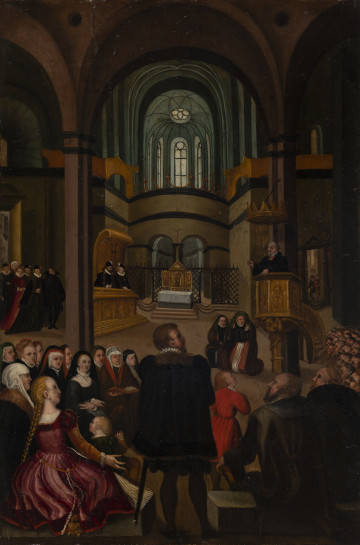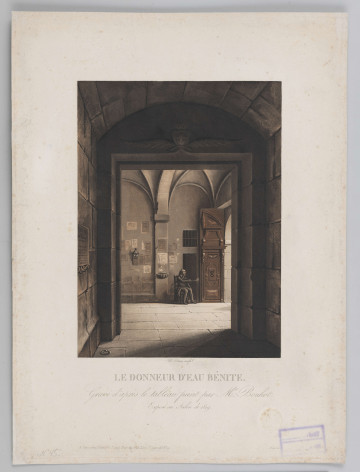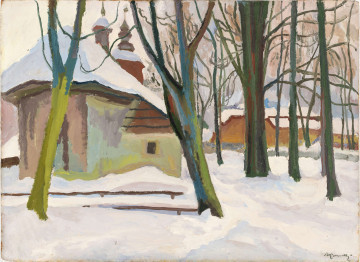
Kazanie w kościele ewangelickim | Sermon in a Protestant church
3. ćwierć XVI wieku
National Museum in Szczecin
Part of the collection: Landscape
In the 17th century in the Netherlands a special kind of painting developed, the subject of which was the interior of church buildings. The artists developed a distinctive way of representation in their paintings, which resulted from an effort to show the whole or the largest possible space of the interior in one composition. To this end, a masterly linear perspective was used, particularly the commonly known frog perspective with a low point of view. In this way, the architecture of even small, intimate buildings acquired a monumental quality. In these calm and dignified interiors, people, portrayed as tiny figures, were a secondary element. This type of painting continued in the following centuries and had its representatives in Polish art of the 19th century, such as Aleksander Gryglewski. One of them was also Marcin Zaleski, a valued landscape painter representing the Neoclassical style. Associated with Krakow and Warsaw, he created mainly vedutas (cityscapes) and views of church interiors. An example of the latter type of representation is Wnętrze kościoła oo. Dominikanów w Krakowie [Interior of the Dominican Church in Kraków]. Although it is partly maintained in the above-mentioned painting tradition, it reveals already other artistic interests and motivations – through the rainbow arch of the presbytery, which is a kind of window in the painting, the view opens onto the interior of the temple – the gaze goes deeper, towards the porch. The nave, shown in a contrasting play of lit fragments, clearly exposed and plunged in semi-darkness, evokes something of the aura of the mystery of the distant past, so close to the hearts of lovers of antiquity and pre-Romantic admiration for the past centuries of the Christian faith. In the foreground, the viewer can see figures of clergy and laity animating a stone interior full of relics of art and piety. The choice of this interior is explained by the great piety and reverence with which this famous 12th-century Krakow sacred building was surrounded. The Dominican Church appears as a reminder of the past, a place of refuge for memory and an object of sentimental reminiscence. The painting also shows the typical features of genre painting, emphasised by the artist's excellent technique. Zaleski's insightful landscape studies were used in the post-war reconstruction of Warsaw.
Bożena Kasperowicz
Author / creator
Dimensions
cały obiekt: height: 50 cm, width: 70 cm
Object type
painting
Technique
oil technique
Material
canvas, oil-based paint
Creation time / dating
Creation / finding place
Owner
The National Museum in Lublin
Identification number
Location / status

3. ćwierć XVI wieku
National Museum in Szczecin

1819
National Museum in Lublin

1st half of the 20th century
National Museum in Lublin
DISCOVER this TOPIC
National Museum in Szczecin
DISCOVER this PATH
Educational path